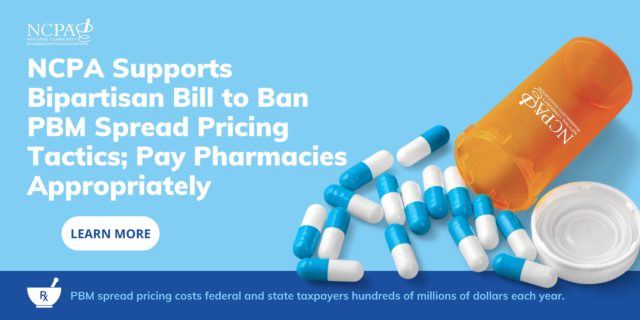What is PBM spread pricing?
In the spread pricing model, PBMs charge a payer more than they reimburse the pharmacy for a certain drug and retain the difference. It is unclear how much of that payment goes to pharmacies and how much of it goes into PBM profit.
Spread pricing contrasts with the “pass-through model,” where PBMs charge payers the same amount that they reimburse pharmacies, plus a set administrative fee. The federal government requires Medicaid fee-for-service providers to use the pass-through model, but it does not apply to PBM contract’s with Medicaid MCOs or in the commercial market.
PBM spread pricing costs federal and state taxpayers hundreds of millions of dollars each year. While it pads PBMs’ pockets, it does nothing to reduce the cost of drugs for Medicaid patients, and it helps drive small business pharmacies out of business, also harming their access to care,” said NCPA CEO B. Douglas Hoey, pharmacist, MBA.
How Does Spread Pricing Work?
Pharmacy benefit managers negotiate prices on each medication a pharmacy dispenses. The PBM pays the pharmacy based on these contracted rates.
Disclosed or not, when a PBM uses this spread pricing tactic to charge more than what they pay the pharmacy, it is referred to as “marking up the spread.” This tactic is sometimes used when they know that the plan sponsor will do nothing about it.
This results in the fact that plan sponsors often pay exorbitant fees without knowing beforehand.
Bipartisan Bill to Ban PBM Spread Pricing Tactics
On November 17th, 2021, HHS, together with DOL and the Treasury Department, joined by the Office of Personnel Management, announced new rules to protect Americans’ health care, releasing an interim final rule with request for comments (IFC), entitled “Prescription Drug and Health Care Spending.”
The National Community Pharmacists Association is proud to stand behind the Drug Price Transparency in Medicaid Act of 2021. This would help prevent predatory pricing tactics used by pharmacy benefit managers at work. The proposed bill would limit prescription drug middlemen to only administering the plan and reimburse pharmacies at a consistent rate. Currently, PBMs can overcharge Medicaid managed care programs, pay pharmacies less for medications dispensed, and keep the difference. This practice is known as the spread. The bipartisan legislation was introduced by Reps. Buddy Carter (R-Ga). (D-Texas).
Prescription Drug and Health Care Spending Requirements
The use of transparency measures in the healthcare industry is emerging as a way to promote competition, cut spending, and increase accountability. The CAA includes a number of provisions aimed at promoting and supporting these efforts, such as the requirement that plans and issuers submit certain information related to prescription drug and other healthcare spending to the Departments.
This data submission is required to include among other things information on the most dispensed and costliest drugs. It also requires providing information about prescription drug rebates paid by manufacturers of drug to the organizations licensed to promote their products.
The CAA requires the Department to publish biennial public reports on behalf of drug approvals, price trends and associated costs.
Summary of the November 17, 2021 IFC
This IFC requires that healthcare plans and issuers submit certain information about prescription drugs and other healthcare-related spending annually to the Department of Health, including:
- General information regarding the plan;
- Enrollment and premium information, including the average monthly premiums both employees and employers pay for healthcare coverage;
- Total healthcare spending, broken down by type of cost (hospital care; primary care; specialty care; prescription drugs; and other medical costs, including wellness services) has been growing exponentially. prescription drug spending among enrollees, employers, and issuers;
- Top 50 frequently dispensed brand-name prescription drugs;
- Top 50 most expensive prescription drugs by spend;
- Top 50 prescription drugs with the highest in plan or coverage expenditures from last year;
- Remuneration and other compensation by the drug manufacturer, such as prescription drug rebates and fees, to health insurers and other organizations which provide prescription medication for their clients. This also includes the 25 drugs with the highest remuneration paid to insurers;
- The impact of prescription drug rebates and fees on premiums and out-of-pocket costs.
One of the key components of the IFC is that it requires plan sponsor, issuers, and FEHB carriers to submit information aggregated at the state or market level.
To ensure that the different government offices and other organizations can take meaningful data analysis and find out which medicines are prescribed most, these new rules also involve the establishment of uniform standards and definitions. This includes a system for identifying what counts as a medicine, regardless of its dose.
Applicability Date and Comment Period
As of December 27, 2021, the CAA will require plans and issuers to submit their yearly health data. They should help ease the process by submitting this information by June 1st every year. The Department of Labor has announced that they will be exercising discretion in enforcement with regard to the December 27, 2021 and June 1, 2022 deadlines, Furthermore, OPM confirmed that it will not enforce enforcement action against an insurance plan or issuer providing the required information for 2020 and 2021 by December 27, 2022. Lastly, OPM gave its FEHB carriers permission to provide data on 2020 and 2021 by December 27, 2022.


